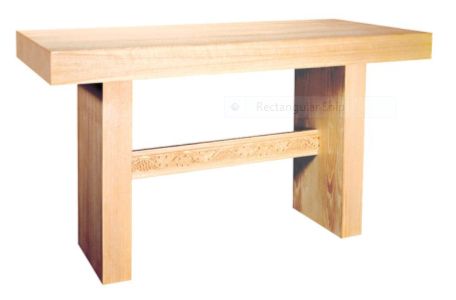Question
I'm now doing adjustable shelves in all my wall cabs and trying to work it to where I have two doors that meet in the middle with no middle stile (faceframe cabs by the way). It is working out pretty well but how wide does a cabinet need to be before it is too long? My concern is the strength of the 3/4 ply shelf.
For example, right now I have a wall cabinet that is 34'' inside the stiles. It seems like that might make the shelf kind of weak? I could put the center stile in and use a petition which would cut the shelf length in half but I don't think it would be as handy to the customer and would be more work. I'm just concerned about a long shelf sagging or possibly the pins not supporting it. So my question is, how long is too long?
Forum Responses
(Cabinetmaking Forum)
From contributor Y:
All of our adjustable shelves, which are all our shelves, have a 5/8 by -1-1/8 nosing. If the shelf is too long we also put one on the back edge. This has been good for us up to 36" without any problems. The material for the nosing comes from our drops from cutting the face frames. The last thing that we cut from our drops is our base shoe. I know this sounds like an expensive approach but I personally think it is nicer looking than just sanding or putting tape on.
If you are using solid-edging of at least 3/4"d x 1"h (we use 3/4" x 1.25") you should have no problem. Play around with the sagulator in the Software Connection and you will understand. If you want to make a friend for life, design your drawer bank to include racks for plates and silverware drawer near the dishwasher (think of washer and dryer next to each other - pick and drop).
A shelf is an engineered structure. When designing a shelf, the controlling feature is almost always the amount of deflection that can be tolerated rather than the ultimate strength. That is, a shelf will be deemed “unsatisfactory” because it bends too much (often 1/4" deflection is considered too much) long before it will break from too heavy a load. An understanding of the basic engineering concepts will help us determine the material to use, thickness, and so on in order to obtain a satisfactory shelf. The basic formula for the deflection of a shelf is (0.1563) (load per inch of span) (length of the span to the 4th power).
(Modulus of elasticity) (width) (thickness to the 3rd power). The load per inch of span is determined by the owner of the shelf; often the shelf is designed to carry a full load of books, which would typically be the heaviest load expected. The span is the distance between the supports. The modulus of elasticity is a measure of the flexibility of the shelf; values for various materials are published in many texts. The width and thickness refer to the shelf size.
Stiffer Shelves
Using this formula, it is easy to answer the question “What can we do, as a manufacturer of a shelf, to reduce the deflection of a shelf?” With less deflection, then the shelf could potentially carry a higher load, or the support spacing (span) could be increased. Let’s look at each variable separately, but understand that they work together. We can shorten the span. Because the span is raised to the 4th power, a small decrease in the span has a dramatic effect on deflection; for example, the reduction in deflection between a 30-inch and 29-inch span is over 10%. We can also decrease deflection by using a stiffer material, which usually means a more dense material. The E-values for several species are
Eastern white pine 1.24 million psi
Southern pine 1.79
Yellow birch 2.01
Soft (silver) maple 1.14
Hard maple 1.83
Red oak 1.82
Walnut 1.68
Yellow-poplar 1.58
In addition to considering a reduction in deflection, stiffer shelving would allow wider spans. For example, switching from Southern pine to oak will permit over 20% longer spans. The shelf width can be increased to stiffen the shelf.
The thickness of the shelf can be increased. Because the thickness is to the 3rd power, a small increase in thickness will greatly reduce deflection. Roughly, going from 3/4inch thickness to 1inch thickness will make the shelf stiffer. This will reduce the deflection in half, or will allow the span to be increased without increasing the deflection above the original amount. For example, a 50% increase in thickness will result in a span increase of nearly 90%.
Other techniques for reducing deflection include putting a solid wood cleat on the back edge. The cleat can run a short distance for a small improvement, or a long distance for a large improvement. Depending on shelf and cabinet design, deflection can be greatly reduced by screwing the back of the shelf to the rear of the cabinet. As noted above, a solid wood nosing on a composite shelf will also stiffen.
Wood composite material typically has lower E-values than solid wood. However, composites can be stiffened by adding a 1-1/4 inch wide solid wood strip to the outside edge, or adding (gluing) solid wood veneer to the top and bottom faces. As an example, a 1-1/4" solid wood edge on plywood will allow the span to be increased about 20%. This is for an immediate deflection. As we know, the deflection will increase with time. So, stiffer will have less deflection now and in the future.
